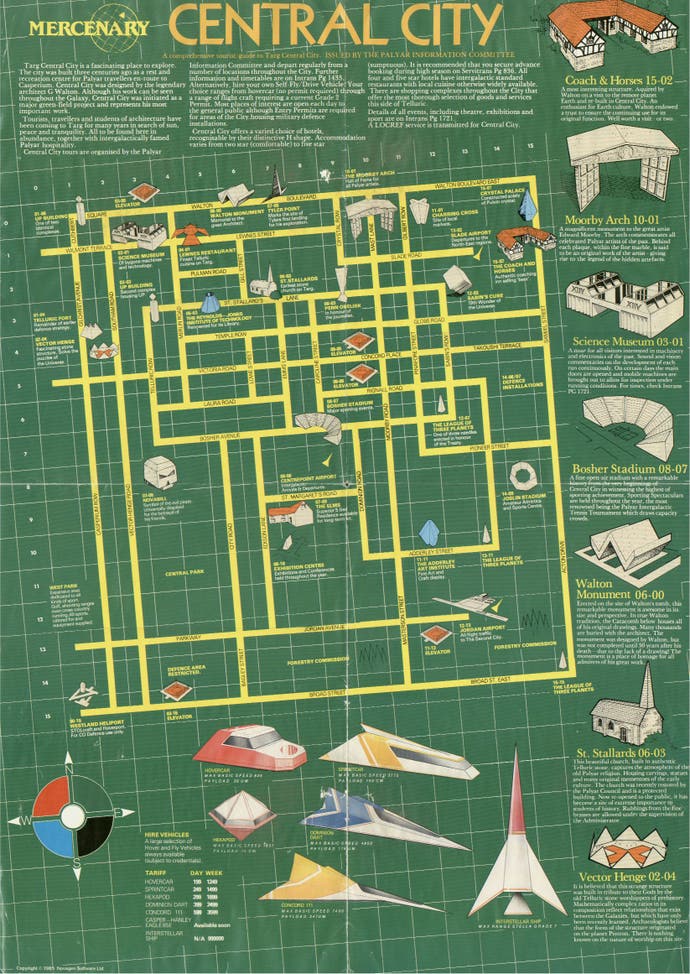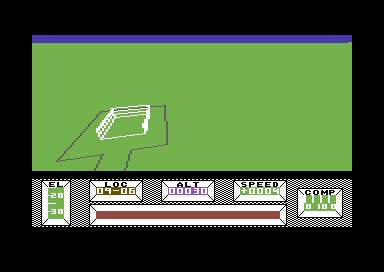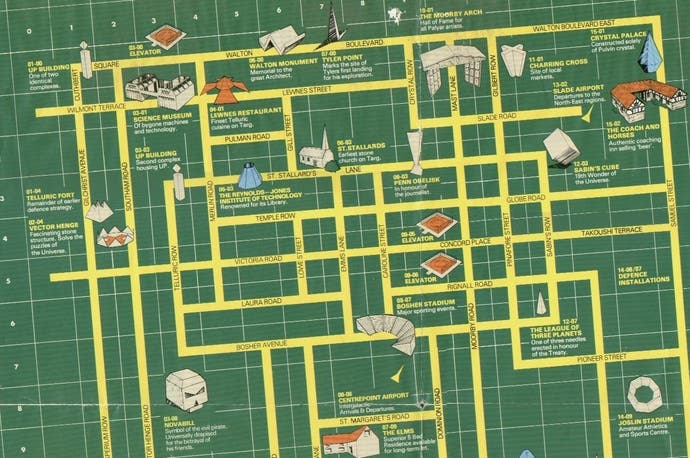Mercenary retrospective
After a week of open worlds, here's a genuine original.
Trace a line back from today's open-world 3D games and you run through the likes of Grand Theft Auto 3 and Morrowind, via Ultima Underworld, to end up at Elite. However, there's one stop-off that's too commonly ignored.
Mercenary was first released in 1985 for the Atari 800 and the Commodore 64 and it rendered an explorable city in wire-frame vector graphics on 8-bit machines. Granted, the frame-rate was a blistering 5fps, but Mercenary combined flight simulation and true exploration in an open and interactive world. It had vehicles, objects and puzzles. There had never been a game like it - so much so that it doesn't really sound like a game from the 1980s at all.
You have crash-landed amidst a civil war on the planet Targ. It's up to you which side to support, but you need to find a way off the planet. Targ features an overground city on a simple grid, with a building at nearly every intersection, and you have a personal computer called Benson, who gives you information and serves as a navigation display. You crash at a small airport, where you can buy a sleek craft, the Dominion Dart, and then you're given a job offer and a grid location to visit. From then on, you're free. I remember getting into the Dart and moving off at speed, then lifting up and taking into the air. It was a revelation. After some flyby sightseeing and the surprise of some aerial combat, I flew to 09-06, landed and coasted into a low wire-frame cage. Looking at the instructions, I wondered if it was an elevator. I pressed 'E' and, boom, my head exploded.
I was lowered down into a large underground hangar. Doors led off to fill out a complex that I could explore at will, with objects in certain rooms that I could pick up, Benson giving me their names. I stumbled around, marvelling at being a person in a world rather than the spaceship in a (pretty samey) universe that I'd been in Elite. When I picked up an object named "Sights", a HUD appeared in my view and it was badass.
I walked through a door marked with a cross and the screen went crazy, suggesting a teleport. I exited and found I was locked in a room with funny-shaped doors. Freaking out, I teleported back the way I came and made a beeline to the hangar. The door to it opened and there's my Dominion Dart waiting for me to hop in, return to the surface and see if I could find any more hangars to explore. It was virtual reality on a home computer and it was amazing. It was also a fundamental shift in my realisation of what games could be, and certainly the reason why I'm such a fiend for Bethesda open-worlders today.
As Mercenary unfolds, the game reveals a thread of subtle cleverness and quirky humour that runs throughout. Oddly shaped doors are opened by picking up identically shaped keys. There are objects with secret abilities; a kitchen sink lets you pick up any object and a cobweb functions as a skeleton key. A box named "essential 12939 supply" turns out to be Pepsi when you view the model from behind (making the most of the engine's lack of hidden line removal). You can pick up the leader of one of the game's factions, with Benson reporting that he insists you put him down.

Most famously, there's an unusually large segment of cheese that also happens to be the fastest ship in the game. Then there's the torrid tale of the Palyar Commander's brother-in-law, a man destined to be your nemesis, should you choose to make him so. Weirdly, it's also impossible to die. You can fling yourself off the Colony Craft without fear, and get shot down by angered drones with little to worry about besides losing your ship.
All of this is uncovered as you roam Targ's complexes and work out your route to escape. The first time I got off the planet was by discovering an unpowered interstellar craft and uniting it with a Novadrive. This involved going through just about every corridor and room in the game, including trips to the Colony Craft and two complexes far off in the wilderness. As I boarded the completed ship, it felt like a shame to be leaving.
Luckily, Mercenary got a remix of the darkly fiendish kind with an expansion pack called The Second City. It expanded further in 1990 with the Damocles series for Amiga and Atari ST, giving players an entire solar system to explore, but the lineage ended there. Those wishing to explore Mercenary and its sequels should visit The Mercenary Site, for even more spoilers than I've already given and a whole lot of excellent background info, including profiles of the entire Novagen team and some insights into Mercenary's author.
Mercenary and its sequels are the work of one man: Paul Woakes. He's one of the great 80s British gaming geniuses; fit to stand alongside Braben and Bell, Mike Singleton, Matthew Smith, Jeff Minter, et al. In Mercenary, Woakes trod a fabulous line with that aforementioned quirky humour to complement his technical excellence. His earlier work included a turbo-paced Battlezone update called Encounter!, which features in Mercenary as a billboard at 02-03. Shooting this advert isn't advisable, as the game refuses to let you leave the planet unless you fix it.
Aside from the japes and the delivery of a true open-world 3D engine in 1985, Woakes also had a wonderful grasp on clean and efficient design. This can be seen in the bare-bones rules of Encounter! and the deliciously crisp graphics of its 16-bit sequel, Backlash. However Mercenary has deeper examples of Woakes' finely pitched taste. Playing on the excellent PC remake, MDDClone, from the excellent Mercenary Site, it's a relief that the navigation system is still excellently intuitive. Things like ship speed being assigned to the number keys are cleverly simple. Besides the wire-frames, animations like a strip of brown moving up the screen as you use a hangar lift is brilliantly illustrative of going underground.

As an interesting aside, the box art is directly representative of the game - an airbrushed vector cityscape as viewed from a cockpit. This goes against the convention of the time, which was gloriously grandiose fantasy and sci-fi paintings, supposedly intended to fill the gaps in imagination left by rudimentary 8-bit graphics. With modern eyes, Mercenary's gameplay itself is obviously primitive but there's definitely a pull to retrace 29-year-old steps, especially with MDDClone's perfectly smooth frame-rate. It's worth mentioning that MDDClone also includes the Second City and both Damocles titles, making it a very tidy little package (around 1.2MB in size) that contains an awful lot of gameplay.
I have to wonder what a modern reboot of Mercenary would be like. The Central City would finally be a thriving metropolis. The lack of lethal consequences and a goal of escape (rather than vanquishing some enemy or other) would be almost subversive in the context of a modern open-world RPG. One meanders around thoughts of deeper and more complex routes to escape, richer factional politics and millions of hidden locations to track down and explore at your leisure.
The point, perhaps, is more about Mercenary's philosophy, which seems to be operating on a higher plain to its contemporaries. A game that's a world to explore and then leave behind, with no killing or emphasis on acquisition. No points awarded, no high-scores, no rewards other than your freedom. It genuinely sounds radical, and if released today would probably sit in the rarefied atmosphere of esoteric art games.

In its day, Mercenary sat with Elite and The Sentinel as 3D games that set a bar far, far beyond the traditional norms, but it lacks recognition and respect. It's always a concern when retrogaming discussion defaults to an offensively simplistic monoculture, where 8-bit UK gaming means Elite and Manic Miner, dodgy arcade conversions and licence tie-ins, and the rest being a load of crap that's not worth looking at today. This is commonly the case in the modern dialogue, save the odd title that stands out by some isolated virtue. Skool Daze was naughty and like real school, Spindizzy was an open-world Marble Madness and so on. Even so, they're seen as islands of genius in a miasma of mediocrity, with little relevance to the modern day.
Mercenary proves this misconception wrong. It's a lost milestone that occupies a spot in a grand, ongoing lineage that still pushes the boundaries of what games can be. If Mercenary proves anything of value to modern games, it's that even in gaming's early days, there were talented designers who weren't afraid to try and build an entire world - one that defiantly went against the grain and broke the rules to produce something eternally special.
As for Paul Woakes, he seemingly disappeared in the 1990s, refusing to fall into old-man roles as the UK games industry steadily consolidated into the monolith that was Eidos. The makers of the upcoming documentary Bedrooms to Billions shot out a tantalising tweet that it had made contact with someone who fits Woakes' bill, so we'll have to hang on a little longer to see if the man behind Mercenary has anything to say. I can only wish I had the opportunity to ask him some questions. The least I can do is salute his game.










